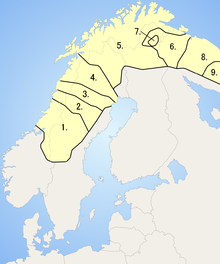Kildin Sami language
| Kildin Sami | |
|---|---|
| (Kiillt saam' kiill) | |
| Native to | Russia |
| Region | Kola Peninsula (Murmansk Oblast) |
|
Native speakers
|
ca. 340 (2010 census) |
| Cyrillic | |
| Language codes | |
| ISO 639-3 | |
| Glottolog | kild1236 |

Kildin Sami is 8 on this map.
|
|
Kildin Sami (also spelled Sámi or Saami; formerly Lappish) is a Sami language spoken by approximately 600 people on the Kola Peninsula in northwestern Russia. Kildin Sami is written using an official Cyrillic script.
The area around Lovozero has the highest concentration of speakers. It is the largest of the Eastern Sami languages by number of speakers. Its future, however, appears to be not as bright as that of Skolt Sami or Inari Sami because the language is used actively by only very few people today. The Sami languages closest to Kildin are Ter Sami and Akkala Sami. The latter is sometimes considered to be a dialect of Kildin Sami.
Kildin Sami is written in an extended version of Cyrillic since the 1980s. The alphabet has three variants with some minor differences in certain letters, mostly in Ҋ vs. Ј and ’ (apostrophe) vs. Һ. Whereas the dictionary of Sammallahti/Khvorostukhina(1991) uses Ҋ and ’ (apostrophe), Kuruč at al. 1985 uses Ј and Һ. The third orthographic variant, used, e.g. by Kert (1986), has neither of these letters.
Note that the letters Ӓ, Ҋ/Ј, Һ/’ (apostrophe), Ӆ, Ӎ, Ӊ, Ӈ, Ҏ, Ъ, Ь, Ҍ and Ӭ do not occur word initially, either because the letters mark features of preceding consonants or the sounds they represent do not occur word initially. So these letters do not normally occur in uppercase, except for all caps text.
The letter Щ occurs only in Russian loanwords.
The orthographic principles are more or less similar to Russian, but note the following special features.
Similar to Russian, palatalization of a consonant in Kildin Sami is marked by the letter Ь or one of the vowel letters Е, Ё, И, Ю, and Я following the consonant. Palatalized Д, Т, Н, however, are marked by ҍ or one of the vowel letters Ӓ and Ӭ. Note also that the consonant letter Н before Ь or one of the vowel letters Е, Ё, И, Ю, and Я does not represent palatalization but the palatal nasal /ɲ/.
...
Wikipedia
